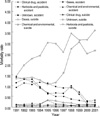Abstract
Figures and Tables
Table 3

Table 6

% (a)#=(total death by each agent/total death by poisoning)×100, % (b)#=(male death by each agent/male death by poisoning)×100, % (c)#=(female death by each agent/female death by poisoning)×100, *P or H: pesticides and herbicides, T60-T609 in ICD-10, †Inhalation gases: T58-T599 in ICD-10, ‡C and E: chemical and environmental toxins, T51-T579, T61-T658 in ICD-10, ¶Clinical drugs: T36-T509 in ICD-10, §Unknown: T659 in ICD-10, misclassification: non T code in ICD-10.
Table 7

*Unknown education: 91 (0.27%), †Unknown region: 35 (0.10%), metropolitan: Seoul, Busan, Incheon, Daegu, Gwaungju, Daejeon and Ulsan Cities; province: all other regions except metropolitan, ‡Unknown marriage: 220 (0.66%), ¶Unknown job: 232 (0.69%) §Others: accidental poisoning, legal intervention, and unknown intent.
Table 8

*Unknown education: 91 (0.27%), †Unknown region: 35 (0.10%), Metropolitan: Seoul, Busan, Incheon, Daegu, Gwaungju, Daejeon and Ulsan Cities; province: all other regions except metropolitan; ‡Unknown marital status: 220 (0.66%); ¶Unknown job: 232 (0.69%); ∥Model 1: adjusted for age group and gender; §Model 2: adjusted for age group, gender, socioeconomic status such as education, region, marriage status, job, and month of death, toxic agent.; **reference group.




 PDF
PDF ePub
ePub Citation
Citation Print
Print










 XML Download
XML Download